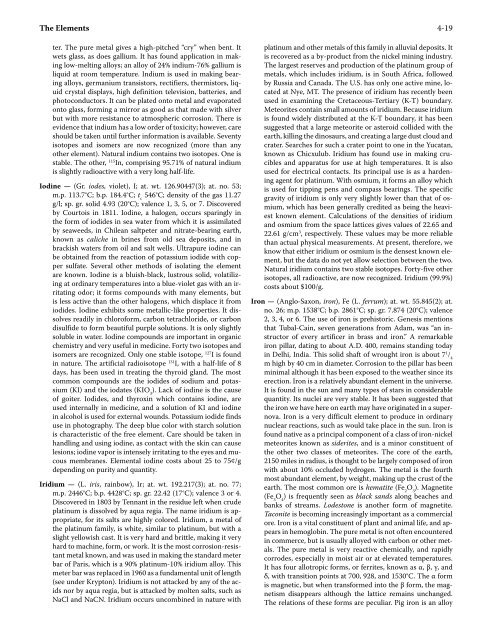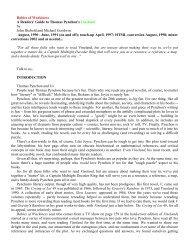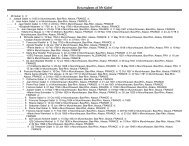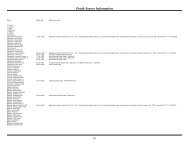CRC Handbook of Chemistry and Physics, 86th Edition
CRC Handbook of Chemistry and Physics, 86th Edition
CRC Handbook of Chemistry and Physics, 86th Edition
Create successful ePaper yourself
Turn your PDF publications into a flip-book with our unique Google optimized e-Paper software.
The Elements 4-19<br />
ter. The pure metal gives a high-pitched “cry” when bent. It<br />
wets glass, as does gallium. It has found application in making<br />
low-melting alloys; an alloy <strong>of</strong> 24% indium-76% gallium is<br />
liquid at room temperature. Indium is used in making bearing<br />
alloys, germanium transistors, rectifiers, thermistors, liquid<br />
crystal displays, high definition television, batteries, <strong>and</strong><br />
photoconductors. It can be plated onto metal <strong>and</strong> evaporated<br />
onto glass, forming a mirror as good as that made with silver<br />
but with more resistance to atmospheric corrosion. There is<br />
evidence that indium has a low order <strong>of</strong> toxicity; however, care<br />
should be taken until further information is available. Seventy<br />
isotopes <strong>and</strong> isomers are now recognized (more than any<br />
other element). Natural indium contains two isotopes. One is<br />
stable. The other, 115 In, comprising 95.71% <strong>of</strong> natural indium<br />
is slightly radioactive with a very long half-life.<br />
Iodine — (Gr. iodes, violet), I; at. wt. 126.90447(3); at. no. 53;<br />
m.p. 113.7°C; b.p. 184.4°C; t c 546°C; density <strong>of</strong> the gas 11.27<br />
g/l; sp. gr. solid 4.93 (20°C); valence 1, 3, 5, or 7. Discovered<br />
by Courtois in 1811. Iodine, a halogen, occurs sparingly in<br />
the form <strong>of</strong> iodides in sea water from which it is assimilated<br />
by seaweeds, in Chilean saltpeter <strong>and</strong> nitrate-bearing earth,<br />
known as caliche in brines from old sea deposits, <strong>and</strong> in<br />
brackish waters from oil <strong>and</strong> salt wells. Ultrapure iodine can<br />
be obtained from the reaction <strong>of</strong> potassium iodide with copper<br />
sulfate. Several other methods <strong>of</strong> isolating the element<br />
are known. Iodine is a bluish-black, lustrous solid, volatilizing<br />
at ordinary temperatures into a blue-violet gas with an irritating<br />
odor; it forms compounds with many elements, but<br />
is less active than the other halogens, which displace it from<br />
iodides. Iodine exhibits some metallic-like properties. It dissolves<br />
readily in chlor<strong>of</strong>orm, carbon tetrachloride, or carbon<br />
disulfide to form beautiful purple solutions. It is only slightly<br />
soluble in water. Iodine compounds are important in organic<br />
chemistry <strong>and</strong> very useful in medicine. Forty two isotopes <strong>and</strong><br />
isomers are recognized. Only one stable isotope, 127 I is found<br />
in nature. The artificial radioisotope 131 I, with a half-life <strong>of</strong> 8<br />
days, has been used in treating the thyroid gl<strong>and</strong>. The most<br />
common compounds are the iodides <strong>of</strong> sodium <strong>and</strong> potassium<br />
(KI) <strong>and</strong> the iodates (KIO 3 ). Lack <strong>of</strong> iodine is the cause<br />
<strong>of</strong> goiter. Iodides, <strong>and</strong> thyroxin which contains iodine, are<br />
used internally in medicine, <strong>and</strong> a solution <strong>of</strong> KI <strong>and</strong> iodine<br />
in alcohol is used for external wounds. Potassium iodide finds<br />
use in photography. The deep blue color with starch solution<br />
is characteristic <strong>of</strong> the free element. Care should be taken in<br />
h<strong>and</strong>ling <strong>and</strong> using iodine, as contact with the skin can cause<br />
lesions; iodine vapor is intensely irritating to the eyes <strong>and</strong> mucous<br />
membranes. Elemental iodine costs about 25 to 75¢/g<br />
depending on purity <strong>and</strong> quantity.<br />
Iridium — (L. iris, rainbow), Ir; at. wt. 192.217(3); at. no. 77;<br />
m.p. 2446°C; b.p. 4428°C; sp. gr. 22.42 (17°C); valence 3 or 4.<br />
Discovered in 1803 by Tennant in the residue left when crude<br />
platinum is dissolved by aqua regia. The name iridium is appropriate,<br />
for its salts are highly colored. Iridium, a metal <strong>of</strong><br />
the platinum family, is white, similar to platinum, but with a<br />
slight yellowish cast. It is very hard <strong>and</strong> brittle, making it very<br />
hard to machine, form, or work. It is the most corrosion-resistant<br />
metal known, <strong>and</strong> was used in making the st<strong>and</strong>ard meter<br />
bar <strong>of</strong> Paris, which is a 90% platinum-10% iridium alloy. This<br />
meter bar was replaced in 1960 as a fundamental unit <strong>of</strong> length<br />
(see under Krypton). Iridium is not attacked by any <strong>of</strong> the acids<br />
nor by aqua regia, but is attacked by molten salts, such as<br />
NaCl <strong>and</strong> NaCN. Iridium occurs uncombined in nature with<br />
platinum <strong>and</strong> other metals <strong>of</strong> this family in alluvial deposits. It<br />
is recovered as a by-product from the nickel mining industry.<br />
The largest reserves <strong>and</strong> production <strong>of</strong> the platinum group <strong>of</strong><br />
metals, which includes iridium, is in South Africa, followed<br />
by Russia <strong>and</strong> Canada. The U.S. has only one active mine, located<br />
at Nye, MT. The presence <strong>of</strong> iridium has recently been<br />
used in examining the Cretaceous-Tertiary (K-T) boundary.<br />
Meteorites contain small amounts <strong>of</strong> iridium. Because iridium<br />
is found widely distributed at the K-T boundary, it has been<br />
suggested that a large meteorite or asteroid collided with the<br />
earth, killing the dinosaurs, <strong>and</strong> creating a large dust cloud <strong>and</strong><br />
crater. Searches for such a crater point to one in the Yucatan,<br />
known as Chicxulub. Iridium has found use in making crucibles<br />
<strong>and</strong> apparatus for use at high temperatures. It is also<br />
used for electrical contacts. Its principal use is as a hardening<br />
agent for platinum. With osmium, it forms an alloy which<br />
is used for tipping pens <strong>and</strong> compass bearings. The specific<br />
gravity <strong>of</strong> iridium is only very slightly lower than that <strong>of</strong> osmium,<br />
which has been generally credited as being the heaviest<br />
known element. Calculations <strong>of</strong> the densities <strong>of</strong> iridium<br />
<strong>and</strong> osmium from the space lattices gives values <strong>of</strong> 22.65 <strong>and</strong><br />
22.61 g/cm 3 , respectively. These values may be more reliable<br />
than actual physical measurements. At present, therefore, we<br />
know that either iridium or osmium is the densest known element,<br />
but the data do not yet allow selection between the two.<br />
Natural iridium contains two stable isotopes. Forty-five other<br />
isotopes, all radioactive, are now recognized. Iridium (99.9%)<br />
costs about $100/g.<br />
Iron — (Anglo-Saxon, iron), Fe (L. ferrum); at. wt. 55.845(2); at.<br />
no. 26; m.p. 1538°C; b.p. 2861°C; sp. gr. 7.874 (20°C); valence<br />
2, 3, 4, or 6. The use <strong>of</strong> iron is prehistoric. Genesis mentions<br />
that Tubal-Cain, seven generations from Adam, was “an instructor<br />
<strong>of</strong> every artificer in brass <strong>and</strong> iron.” A remarkable<br />
iron pillar, dating to about A.D. 400, remains st<strong>and</strong>ing today<br />
in Delhi, India. This solid shaft <strong>of</strong> wrought iron is about 7 1 / 4<br />
m high by 40 cm in diameter. Corrosion to the pillar has been<br />
minimal although it has been exposed to the weather since its<br />
erection. Iron is a relatively abundant element in the universe.<br />
It is found in the sun <strong>and</strong> many types <strong>of</strong> stars in considerable<br />
quantity. Its nuclei are very stable. It has been suggested that<br />
the iron we have here on earth may have originated in a supernova.<br />
Iron is a very difficult element to produce in ordinary<br />
nuclear reactions, such as would take place in the sun. Iron is<br />
found native as a principal component <strong>of</strong> a class <strong>of</strong> iron-nickel<br />
meteorites known as siderites, <strong>and</strong> is a minor constituent <strong>of</strong><br />
the other two classes <strong>of</strong> meteorites. The core <strong>of</strong> the earth,<br />
2150 miles in radius, is thought to be largely composed <strong>of</strong> iron<br />
with about 10% occluded hydrogen. The metal is the fourth<br />
most abundant element, by weight, making up the crust <strong>of</strong> the<br />
earth. The most common ore is hematite (Fe 2 O 3 ). Magnetite<br />
(Fe 3 O 4 ) is frequently seen as black s<strong>and</strong>s along beaches <strong>and</strong><br />
banks <strong>of</strong> streams. Lodestone is another form <strong>of</strong> magnetite.<br />
Taconite is becoming increasingly important as a commercial<br />
ore. Iron is a vital constituent <strong>of</strong> plant <strong>and</strong> animal life, <strong>and</strong> appears<br />
in hemoglobin. The pure metal is not <strong>of</strong>ten encountered<br />
in commerce, but is usually alloyed with carbon or other metals.<br />
The pure metal is very reactive chemically, <strong>and</strong> rapidly<br />
corrodes, especially in moist air or at elevated temperatures.<br />
It has four allotropic forms, or ferrites, known as α, β, γ, <strong>and</strong><br />
δ, with transition points at 700, 928, <strong>and</strong> 1530°C. The α form<br />
is magnetic, but when transformed into the β form, the magnetism<br />
disappears although the lattice remains unchanged.<br />
The relations <strong>of</strong> these forms are peculiar. Pig iron is an alloy







